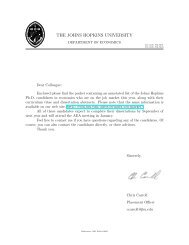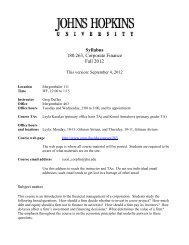WEALTH, DISPOSABLE INCOME AND CONSUMPTION - Economics
WEALTH, DISPOSABLE INCOME AND CONSUMPTION - Economics
WEALTH, DISPOSABLE INCOME AND CONSUMPTION - Economics
Create successful ePaper yourself
Turn your PDF publications into a flip-book with our unique Google optimized e-Paper software.
46<br />
includes human wealth and non-human wealth (excluding equity). 9 The<br />
lower panel of Figure 14 focusses attention on the two most recent business<br />
cycles, reporting dynamic simulations starting in 1980.<br />
The graphs reveal that both EC models track the broad movements<br />
in consumption reasonably well. Prior to the 1980s, the Keynesian EC<br />
equation and wealth-augmented model have very similar dynamic forecasts,<br />
but in the 1980s there are some more marked differences. Although<br />
both equations underpredict the decline in consumption experienced during<br />
the 1981–82 recession, the equation including wealth explains a considerably<br />
larger proportion of the observed peak-to-trough decline – 85 per<br />
cent as compared with only 51 per cent for the Keynesian equation. The<br />
equation including wealth also tracks observed consumption more closely<br />
in the latter half of the 1980s.<br />
Strong growth in both human wealth and non-human wealth<br />
excluding equity through the 1987–88 period results in a considerably<br />
higher predicted level of consumption by the start of 1989, when wealth is<br />
included. As a result, the wealth-augmented model does a much better job<br />
of explaining the consumption boom in the late 1980s. This is consistent<br />
with the view that rising asset values, particularly housing prices, fuelled<br />
high levels of consumption over this period.<br />
Looking at the most recent recession, we see that neither equation<br />
can account for the magnitude of the fall in consumption through 1990 –<br />
both equations predict about half the observed decline. For the period following<br />
the recession, both equations predict little consumption growth<br />
through 1991 and 1992, with a slight pickup in 1993. While actual consumption<br />
growth remained weak in 1993, the tempting conclusion is that<br />
stronger consumption growth is just around the corner.<br />
9. The dynamic simulations (not shown) for the model using total wealth are very similar<br />
though marginally inferior to those with human and non-human wealth (excluding equity)<br />
entered separately.




